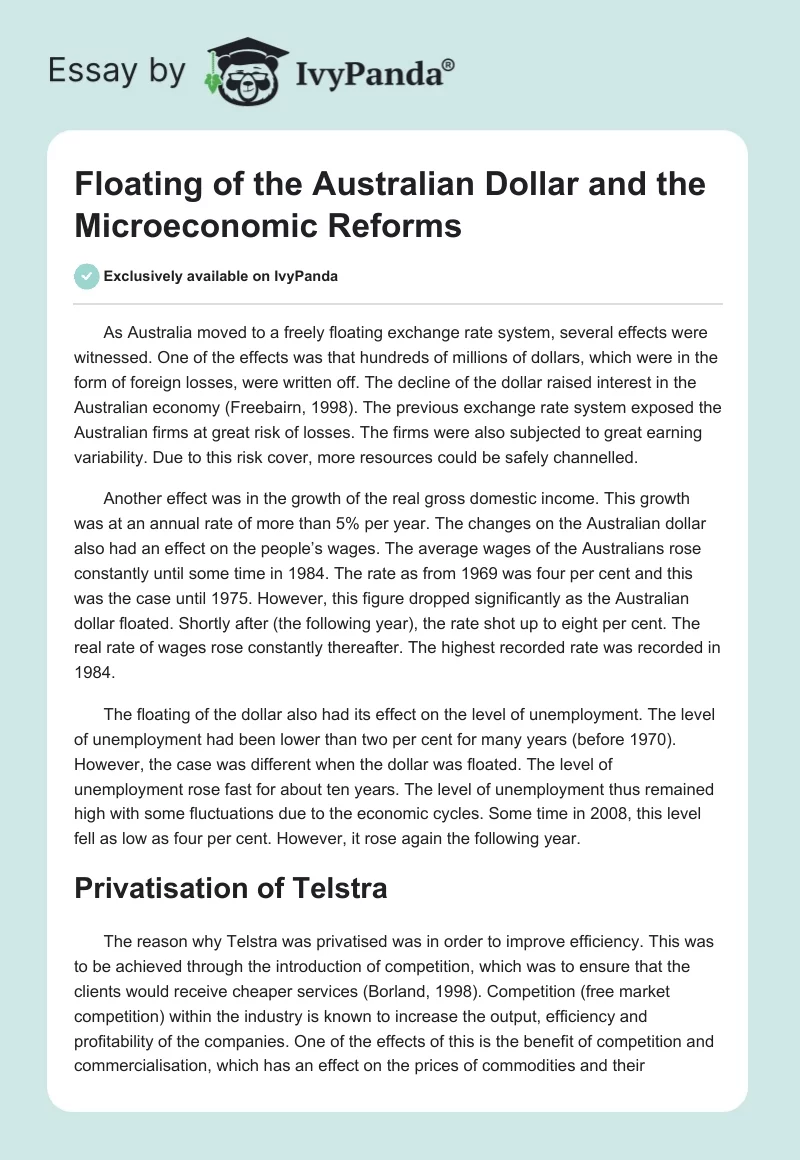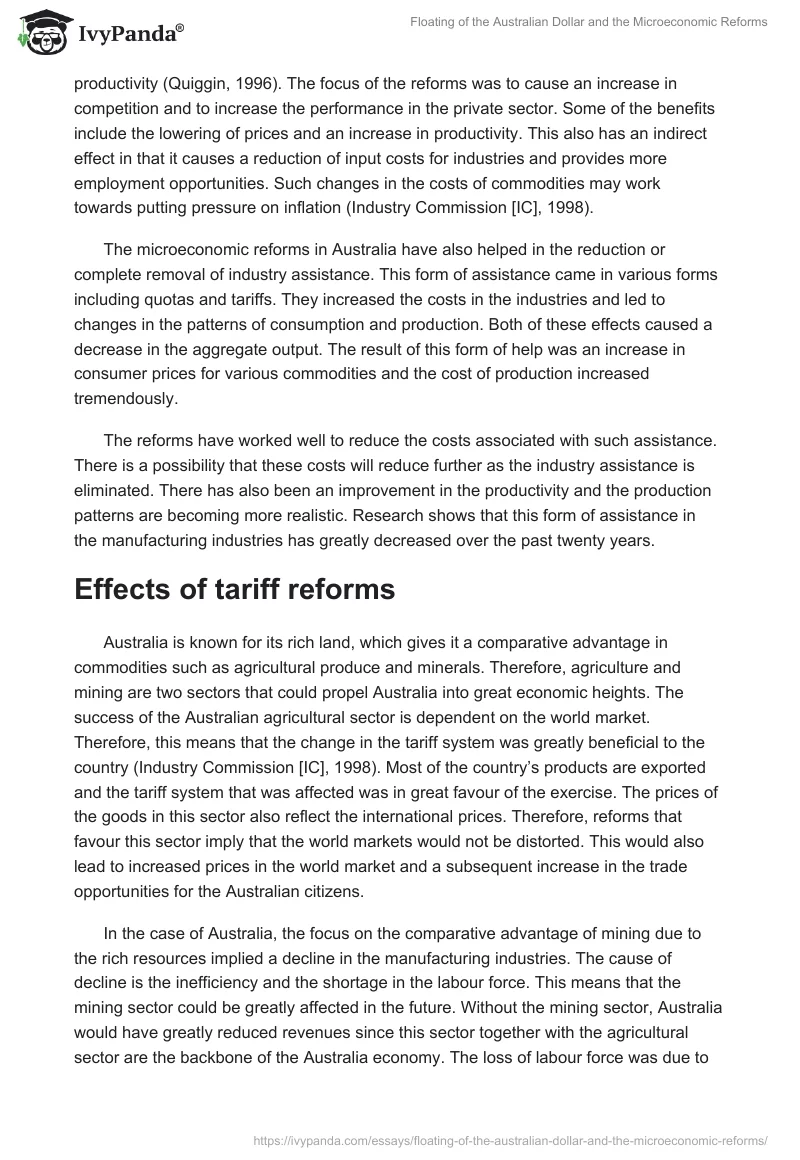As Australia moved to a freely floating exchange rate system, several effects were witnessed. One of the effects was that hundreds of millions of dollars, which were in the form of foreign losses, were written off. The decline of the dollar raised interest in the Australian economy (Freebairn, 1998). The previous exchange rate system exposed the Australian firms at great risk of losses. The firms were also subjected to great earning variability. Due to this risk cover, more resources could be safely channelled.
Another effect was in the growth of the real gross domestic income. This growth was at an annual rate of more than 5% per year. The changes on the Australian dollar also had an effect on the people’s wages. The average wages of the Australians rose constantly until some time in 1984. The rate as from 1969 was four per cent and this was the case until 1975. However, this figure dropped significantly as the Australian dollar floated. Shortly after (the following year), the rate shot up to eight per cent. The real rate of wages rose constantly thereafter. The highest recorded rate was recorded in 1984.
The floating of the dollar also had its effect on the level of unemployment. The level of unemployment had been lower than two per cent for many years (before 1970). However, the case was different when the dollar was floated. The level of unemployment rose fast for about ten years. The level of unemployment thus remained high with some fluctuations due to the economic cycles. Some time in 2008, this level fell as low as four per cent. However, it rose again the following year.
Privatisation of Telstra
The reason why Telstra was privatised was in order to improve efficiency. This was to be achieved through the introduction of competition, which was to ensure that the clients would receive cheaper services (Borland, 1998). Competition (free market competition) within the industry is known to increase the output, efficiency and profitability of the companies. One of the effects of this is the benefit of competition and commercialisation, which has an effect on the prices of commodities and their productivity (Quiggin, 1996). The focus of the reforms was to cause an increase in competition and to increase the performance in the private sector. Some of the benefits include the lowering of prices and an increase in productivity. This also has an indirect effect in that it causes a reduction of input costs for industries and provides more employment opportunities. Such changes in the costs of commodities may work towards putting pressure on inflation (Industry Commission [IC], 1998).
The microeconomic reforms in Australia have also helped in the reduction or complete removal of industry assistance. This form of assistance came in various forms including quotas and tariffs. They increased the costs in the industries and led to changes in the patterns of consumption and production. Both of these effects caused a decrease in the aggregate output. The result of this form of help was an increase in consumer prices for various commodities and the cost of production increased tremendously.
The reforms have worked well to reduce the costs associated with such assistance. There is a possibility that these costs will reduce further as the industry assistance is eliminated. There has also been an improvement in the productivity and the production patterns are becoming more realistic. Research shows that this form of assistance in the manufacturing industries has greatly decreased over the past twenty years.
Effects of tariff reforms
Australia is known for its rich land, which gives it a comparative advantage in commodities such as agricultural produce and minerals. Therefore, agriculture and mining are two sectors that could propel Australia into great economic heights. The success of the Australian agricultural sector is dependent on the world market. Therefore, this means that the change in the tariff system was greatly beneficial to the country (Industry Commission [IC], 1998). Most of the country’s products are exported and the tariff system that was affected was in great favour of the exercise. The prices of the goods in this sector also reflect the international prices. Therefore, reforms that favour this sector imply that the world markets would not be distorted. This would also lead to increased prices in the world market and a subsequent increase in the trade opportunities for the Australian citizens.
In the case of Australia, the focus on the comparative advantage of mining due to the rich resources implied a decline in the manufacturing industries. The cause of decline is the inefficiency and the shortage in the labour force. This means that the mining sector could be greatly affected in the future. Without the mining sector, Australia would have greatly reduced revenues since this sector together with the agricultural sector are the backbone of the Australia economy. The loss of labour force was due to the restructuring. The short-term effect yields unemployment but has the benefits of long-term efficiency in the Australian economy.
Protectionist policy
The reduction in protectionism and the competitive environment fostered by the National Competition Policy was advantageous to the Australian economy since it exposed it to greater international competition (Gruen, 1997). As a result, there was a greater demand of imports since they have become cheaper. This has resulted in greater competition for domestic firms and has encouraged them to improve their productivity and efficiency through the use of better technology and innovation. It can also allow producers to expand output and exploit economies of scales, thus attract new foreign investment opportunities leading to a transfer of technical expertise and capital accumulation. This would subsequently stimulate productivity, growth and lead to higher economic growth.
Competition policy
The competition policy was put in place in order to ensure efficiency in the economy of Australia. This was also meant to increase efficiency in the allocation of resources. One of the benefits was the lowering of the prices of commodities. This was the case since there was a significant increase in productivity. This has a ripple effect in that it causes an increase in productivity in the market. The competitive neutrality reforms also favoured the smaller businesses. The publicly owned businesses could not enjoy greater advantage than the privately owned ones. The taxes levied on them ensured equality with the opponents. Access to infrastructure services was also ensured by these reforms. Particularly, the National Competition Policy Reform Act 1995 ensured this. It provided three ways in which businesses could gain access to the services. One of the ways was through making an application to the National Competition Council. Another was through the use of territory access regime. Lastly, one could access them using the terms provided by the Australian Competition and Consumer Commission.
References
Borland, J 1998, Microeconomic reform and displaced workers – an introduction, Ausinfo, Canberra.
Freebairn, J 1998, The effects of microeconomic reforms on product and factor markets: Microeconomic Reform and Productivity Growth, Ausinfo, Canberra.
Gruen, F 1997, ‘Irrational expectations? John Quiggin’s critique of microeconomic policy in Australia’, Agenda, vol. 4, no. 1, pp. 197-208.
Industry Commission 1998, Microeconomic Reforms in Australia: A Compendium from the 1970s to 1997, AGPS, Canberra.
Quiggin, J 1996, Great Expectations: Microeconomic Reform and Australia, Ausinfo, Canberra.


